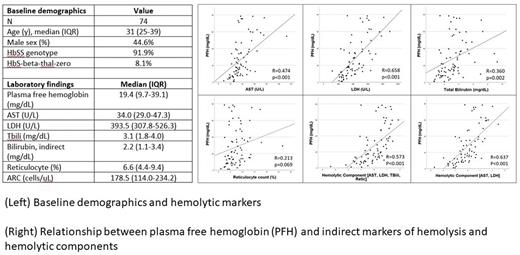Abstract
Introduction: Plasma free hemoglobin (PFH) is a direct hemolytic marker that can estimate the severity of hemolysis in both the chronic and acute settings in sickle cell patients. Elevated PFH has been associated with clinical complications such as pulmonary hypertension, cerebral vasculopathy, and death in this population. Its relationship to other hemolytic biomarkers has not been well established. Furthermore, turnaround time for PFH may be days, diminishing its clinical utility in the acute setting. We sought to characterize the relationship between PFH and more clinically available hemolytic markers including lactate dehydrogenase (LDH), aspartate transaminase (AST), bilirubin, reticulocyte percentage, as well as a statistically derived composite score called the "hemolytic component."
Methods: Baseline PFH and hemolytic markers (AST, LDH, bilirubin, reticulocyte percentage) were obtained from sickle cell patients (HbSS or HbS-beta-thal-zero) enrolled in the IMPROVE II study, prior to intervention. Linear regression analysis was used to evaluate the correlation between PFH and individual variables. Principal component analysis was used to derive a composite hemolytic score using combinations of these biomarkers. The hemolytic score was then compared to PFH.
Results: In a cohort of 74 adult sickle cell patients (median age 31 years old, IQR 25-39), median PFH was elevated at 19.4mg/dL (IQR 9.7-39.1 mg/dL) and was significantly associated with LDH (R=0.658, p<0.001), AST (R=0.474, p<0.001), total bilirubin (R=0.360, p=0.002), and indirect bilirubin (R=0.333, p=0.004), but not with reticulocyte percentage (R=0.213, p=0.069) or absolute reticulocyte count (R=0.150, p=0.204). A hemolytic component derived from the four conventional hemolytic markers (AST, LDH, bilirubin, reticulocyte percentage) was significantly associated with PFH (R=0.573, p<0.001). The best performing hemolytic component derived from just two variables, AST and LDH, correlated with PFH (R=0.637, p<0.001)
Conclusion: PFH correlated with LDH, AST, and bilirubin, but surprisingly not reticulocyte percentage, reaffirming that this biomarker is more specific to intravascular hemolysis. The results also support the idea that the hemolytic component is a valid tool to measure hemolysis, however, LDH may be an adequate and better surrogate biomarker by itself. Further studies will be needed to determine a clinically useful gold standard for measurement of hemolysis in sickle cell disease.
Disclosures
Curtis:Novartis: Honoraria; Global Blood Therapeutics: Consultancy, Honoraria. Glassberg:Novartis: Consultancy; CSL Behring: Consultancy.
Author notes
Asterisk with author names denotes non-ASH members.


This feature is available to Subscribers Only
Sign In or Create an Account Close Modal